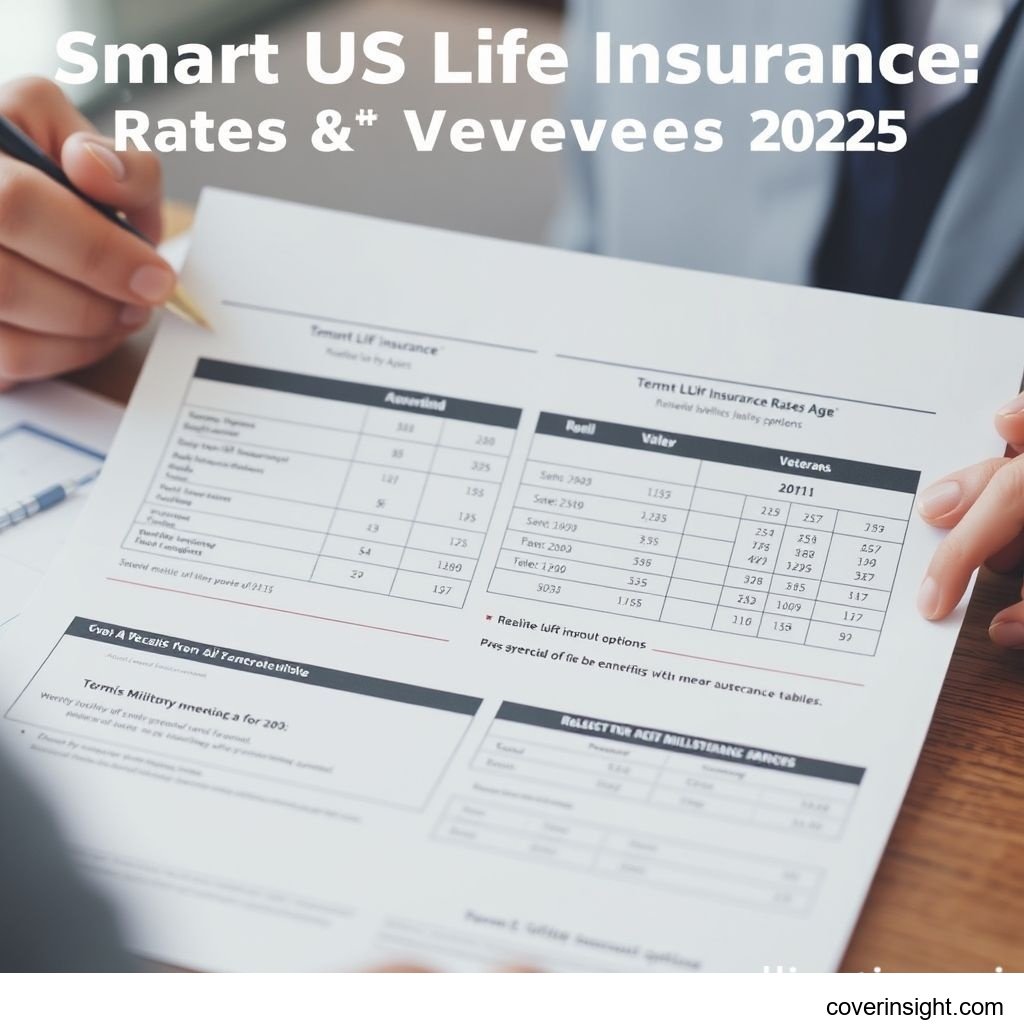Introduction
Understanding term life insurance rates by age in the US for 2025 is more critical than ever, whether you're a civilian or a US veteran. Life insurance isn't just a financial product; it's a safety net, a promise to protect your loved ones financially if the unthinkable happens. As you age, these rates typically change, making it vital to grasp how age, health, and lifestyle choices impact your premiums. This guide aims to demystify the process, helping you make informed decisions for your family's future, offering insights into what to expect from Term Life Insurance Rates by Age in 2025: Your US Guide.
Coverage Details
Navigating the world of term life insurance can feel like a maze, but understanding its core components is the first step toward securing peace of mind.
What’s Included
Term life insurance provides coverage for a specific period, or "term," typically 10, 20, or 30 years. If the insured passes away within this term, their beneficiaries receive a pre-determined death benefit, which is usually tax-free. This lump sum can be used for various purposes, from covering funeral costs and outstanding debts (like mortgages or student loans) to replacing lost income, ensuring children's education, or even setting up an emergency fund for the family. Many policies also offer optional riders, such as accelerated death benefits for terminal illness, disability waivers of premium, or accidental death benefits, adding layers of protection tailored to individual needs. For US veterans, specific programs like Servicemembers' Group Life Insurance (SGLI) and Veterans' Group Life Insurance (VGLI) offer robust coverage options, often at competitive rates, designed to transition seamlessly from military service to civilian life.
Common Exclusions
While term life insurance is a powerful tool, it's not a silver bullet. Common exclusions exist, and being aware of them can prevent unwelcome surprises down the road. Most policies have a suicide clause, typically excluding payouts if the insured dies by suicide within the first two years of the policy. Misrepresentation on the application (e.g., failing to disclose a serious medical condition or dangerous hobby) can also lead to the insurer denying a claim. Certain high-risk activities, such as aviation (unless explicitly covered by a rider), extreme sports, or participation in illegal activities, might also be excluded or require special underwriting. It's always a good idea to pore over the fine print or consult with your insurer to ensure your understanding of these exclusions is crystal clear.
Cost Analysis
The cost of term life insurance isn't a one-size-fits-all figure. Several factors play a significant role in determining your premium.
Price Factors
When it comes to term life insurance rates by age, age is, without a doubt, the most significant factor. Generally, the younger and healthier you are when you apply, the lower your premiums will be. Gender also plays a role, with women typically paying less due to longer average life expectancies, as noted by the Centers for Disease Control and Prevention (CDC) statistics which consistently show women outliving men in the US. Your health status is another critical determinant; pre-existing conditions, high blood pressure, diabetes, or a history of serious illness will push rates higher. Lifestyle choices, like smoking, excessive alcohol consumption, or engaging in hazardous occupations or hobbies (think skydiving or professional racing), are red flags for insurers, leading to higher premiums. The policy's term length and the coverage amount (the death benefit) also directly influence the cost – a longer term or a higher benefit amount means a higher premium. For veterans, service-related disabilities or health conditions might be considered, but programs like VA benefits can help offset some costs.
Saving Tips
Looking to save a few bucks on your term life insurance? There are several savvy strategies you can employ. First off, locking in a policy when you're young and healthy is your best bet; you'll secure lower rates for the long haul. Quitting smoking or adopting a healthier lifestyle can significantly reduce your premiums over time. Many insurers offer incentives for healthy habits, sometimes even integrating wellness programs. Consider whether you truly need a 30-year term or if a 20-year policy aligns better with your financial goals, like paying off a mortgage or seeing your children through college. Shopping around is paramount. Don't just settle for the first quote you receive. Compare offers from multiple providers – both traditional insurers and those specializing in veteran benefits – to find the most competitive rates. Websites like the National Association of Insurance Commissioners offer valuable resources for comparing policies and understanding regulations, and you might find more general advice on Insurance Resources Global. Also, consolidating your insurance needs with one provider might earn you multi-policy discounts.
FAQs
How much does term life insurance rates by age cost?
The cost varies wildly based on age, health, gender, coverage amount, and term length. For a healthy 30-year-old non-smoker, a $500,000, 20-year term policy might cost anywhere from $25-$35 per month. For a 50-year-old with similar coverage, it could jump to $60-$100 or more, reflecting the increased risk. Veterans may find slightly different rate structures through VA-backed programs, often very competitive due to their unique group underwriting. As someone living in the US, I’ve seen firsthand how these rates can fluctuate year to year, so it's wise to get personalized quotes.
What affects premiums?
As discussed, age, gender, health history (including family medical history), lifestyle choices (smoking, alcohol, hazardous hobbies), occupation, the term length, and the death benefit amount are the primary drivers of premium costs. A less obvious factor is your driving record; a history of DUIs or multiple accidents can signal higher risk to an insurer. Even your credit score can subtly influence premiums, as some insurers use it as an indicator of overall financial responsibility.
Is it mandatory?
No, term life insurance is not mandatory in the US. Unlike auto insurance or health insurance (which, while not strictly mandatory, has significant implications for not having it, as seen on Healthcare.gov), life insurance is a voluntary purchase. However, for many, it's considered a cornerstone of sound financial planning, especially for those with dependents or significant debts.
How to choose?
Choosing the right policy involves assessing your financial needs. How much income would your family need to replace? How long would they need it? Consider your debts, future expenses like college tuition, and ongoing living costs. Then, determine a term length that aligns with these needs – perhaps until your children are grown or your mortgage is paid off. Always get multiple quotes and compare them not just on price but also on the insurer's financial strength ratings, customer service, and policy features. Your State Insurance Departments can also provide regulatory information and consumer guides.
Consequences of no coverage?
The consequences of not having life insurance can be severe for your loved ones. Without a death benefit, your family might struggle to cover immediate expenses like funeral costs, which average around $7,000-$10,000 in the US. They could face financial hardship in replacing your income, potentially leading to lifestyle changes, difficulty paying bills, or even losing their home. Take, for example, the case of the Miller family in Ohio; after Mr. Miller, a veteran, passed away unexpectedly without life insurance, his wife and two young children faced immense financial strain, relying heavily on community support and small VA survivor benefits, when a well-structured term policy could have provided a substantial cushion. It's truly about protecting your family from financial despair, offering them a crucial buffer during an emotionally trying time. For a holistic view of insurance needs, you might also visit US Insurance Home.
Author's Insight & Experience: Based on my experience living in the US and navigating personal finance, the sheer volume of choices in the life insurance market can be overwhelming. It’s easy to feel like you’re trying to catch smoke, but don't let perfect be the enemy of good. My professional observation is that procrastination is the biggest enemy when it comes to life insurance. Every year you wait, the rates creep up, and if your health takes a hit, you might even become uninsurable or face exorbitant premiums. The peace of mind that comes from knowing your loved ones are protected, come what may, is truly invaluable. It’s an investment in their future, giving them a fighting chance even if you're not around to provide for them.
Further reading: Term Life Insurance Rates by Age in 2025: Your US Guide








Comments